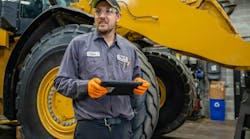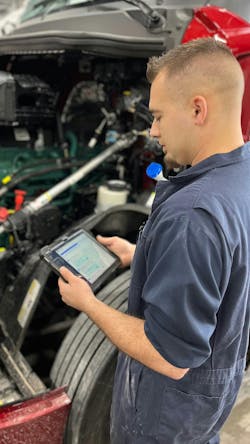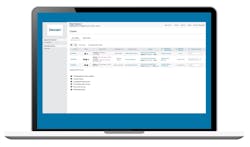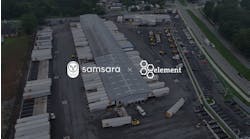Hayden Price, senior technical product manager for Heavy Construction Systems Specialists (HCSS), which developed the Equipment 360 fleet management platform, noted digitization and the use of maintenance software maximizes throughput inside the shop and leads to cost savings. Equipment 360 allows users to create and manage digital work orders and estimates, track maintenance schedules, manage inventory, and automate reporting, all through a PC or mobile device.
“Faster approvals and communication cut down on delays, and digital inventory tracking helps prevent over-ordering or shortages,” he explained, adding that “automation reduces human error, minimizes unnecessary purchases, and helps prevent expensive misplacements of tools or equipment.”
While new technology is making it easier to digitize everything from work orders and estimates to workflows and inventory management, shops are in various stages of adoption, with many still relying on handwritten notes.
“Going paperless is a journey that many industries have taken over the last 30 years, but commercial repair shops are just now starting that journey,” said Patrick McKittrick, CEO of Fullbay. “We can take all the processes shops use to do their work and digitize them, so instead of writing everything down on a form, you put it in a computer.”
Nordstrom said he sees shops using a “hodgepodge of different tools and paper to try to accomplish the same thing,” but once they are fully digital, they don’t want to go back.
Brown was most surprised by how much techs enjoy having a forum to connect and ask questions using the Decisiv platform’s communication feature. This allows technicians to send and receive notes, even tapping into their work devices after hours to chime in. A lot of techs have also added Decisiv’s app to their cell phones, so they know exactly when they get a notification.
“We observed early on that our techs could now not only rely on their ‘at work’ colleagues for support but also their off-duty team members as well,” he explained. “That wasn’t asked for and that wasn’t mandated.”
Plus, techs are assigned their work before they even arrive to the site and are often engaged well before arrival, so they don’t need to speak to their supervisor or foreman before starting work.
Robert Nordstrom, vice president of product enablement for Decisiv, said the most significant return on investment for fleets comes from reducing the number of days equipment is out of service. “We’re trying to increase the amount of time that your vehicle is actually on the road, generating revenue,” he said.
Getting started
For maintenance operations looking to get started on their journey towards paperless operations, work orders are one of the easiest places to start, said Don Stracener, a partner at VMT Software, which makes Digital Wrench. “You enter information about the vehicle, parts, and labor. Now you have your estimate and/or a work order,” he said.
Shops need a computer or laptop with Windows to run Digital Wrench. “Depending on where they buy it and what they buy, they could get into hardware for a single-person or two-person shop for probably $500 plus our software costs,” Stracener explained.
Work orders can be assigned to a technician, or an estimate can be sent to a customer for approval. Any updates to an estimate are tracked in a revision log. “We are tracking how that came in, by person, by phone, by text, what the results were and what the revised estimate is, and then we can email that to them,” Stracener said.
Fullbay also allows technicians to create estimates online, which can be sent to customers via text, email or an online portal. “They can approve or deny the estimate. Then, the shop has the electronic approval. There is no question of if the invoice was approved or not,” McKittrick said.
Creating a digital trail of communication provides a single source of truth. “If we do it digitally, we know exactly who did it and why,” Nordstrom explained.
Brown said he has seen countless occasions where being paperless has cleared up internal and external miscommunications. “There is no more he said/she said verbal misunderstandings or forgotten communication,” he said, adding that Decisiv’s system has been invaluable for customer conflict resolution because there are no more questions about timelines, approvals, or quoted amounts.
Even fleets that have invested in digital solutions often have information coming in from multiple sources, including telematics devices, making it difficult to track. FleetHD aims to bring those together, connecting fleets, dealers, and service centers to create that essential single source of truth while reducing the risk of errors.
“You know the year, make, model, engine type, and all the active diagnostic trouble codes, and you have alert history,” said Steve Blair, co-founder of FleetHD. “You don’t have a manual process of re-entry. It can be automated. That gets you off on the right start before a work order is generated.”
Digitization also reduces the risk of misreading someone’s notes. “One of the biggest benefits of going paperless is probably just the fact that you’re not chasing greasy fingerprints on repair orders or trying to read technicians’ handwriting. That’s always been a challenge for everyone,” Nordstrom said.
Douglas Orr, program manager of AdjustRite, a PPG-owned commercial estimating platform, also sees value in simply eliminating manual record-keeping and managing physical paperwork. With AdjustRite, shops can transition to a fully digital workflow, eliminating the need for any handwritten notes.
Maximizing time and billables
At Vision Truck Group, technicians, service bays, the back parts counter, parts agents, front service counter, service advisors, foremen, supervisors, and warranty department are in constant communication electronically. Decisiv works on a computer, tablet, or cell phone, and employees that didn’t have a dedicated PC or laptop were issued a company iPad. The company initially purchased 120 iPads, which are lasting four to six years. “A tech without his iPad is unable to complete his duties or work in the shop,” Brown said.
Being connected saves time because people don’t have to walk around to find answers or pick up parts, which are delivered right to technicians’ bays. “If I’m submitting my parts request from the bay, I’m staying in the bay and being more productive, which means I’m getting more throughput out of that service bay,” Nordstrom said.
Digitization helps managers and technicians prioritize jobs and make changes if an emergency or high-priority repair comes in. “It shows them exactly what they’re going to be doing today, and they can electronically communicate with the manager when they’re done,” McKittrick said. “In so many shops, the technician is going to the manager saying, ‘I finished this job. What do you want me to do next?’”
As part of the paperless transition, technicians can track their work, log hours, and provide detailed updates. “You have a history of everything that was done on that truck, not because I purposely wrote it down but because the program will automatically log those in the history as the service is being completed,” McKittrick said.
With Digital Wrench’s labor logger, technicians log in and out, which Stracener said is especially useful for large jobs or if multiple technicians are working on the same vehicle. “If you have multiple repairs on a vehicle, you can assign different technicians different jobs to coordinate that repair work,” he said. “When one technician logs out, it will automatically transfer the repair order to whoever’s working on the job next.”
Having access to previous repairs can also save time. “It is like a private repository of data,” Blair said, adding that techs can look up past service dates, parts used, and what happened the last time a fault occurred. “It can guide them in the shop.”
The data captured within software enables smarter, simpler, easier, and more detailed record-keeping so that shop operators can make better decisions about staffing, inventory, equipment purchases, and budgets, Price explained.
Data ensures shops are prepared. “You start to analyze data to say, ‘In this region, we use more of this part, so we want to make sure we have more of those available and have those placed there by the vendors,’” explained Greg Murphy, president of FleetHD.
When technicians log everything in a single platform, they’re less likely to forget to bill for time or parts. “Some customers report that they are generating more revenue after adopting digital systems,” Orr said.
Orr recommends that shops work from a parts list, whether using the AdjustRite system software or any other system. “This ensures all items are captured and accounted for, maximizing revenue and minimizing oversights,” he said.
Paperless systems also provide a foundation for justifying labor times and costs, which Orr said fosters better communication and agreement between shops and insurance companies on collision repairs.
Once work is complete, invoicing can be done quickly. “Because you’re building the service order and logging the completion of tasks in the system, you can generate an invoice with the click of a button,” McKittrick said. “You can send the invoice to the customer, and then that customer has the ability to pay online without someone from the shop having to call them and get their credit card number or wait for a check to be mailed.”
Managing expectations
Transitioning to paperless operations can present a learning curve, particularly for employees using traditional paper-based systems. “Workers may initially struggle with getting used to the software’s features, and the shift in processes, such as digitizing work orders and material tracking, can take a little time,” Price said.
Training and around-the-clock tech support can allow shops to address issues early. “It’s also key that leadership within companies actively communicates the benefits of the transition to foster a positive attitude toward the change,” Price explained.
Nordstrom said a successful transition takes discipline no matter where shops decide to start. “It is easy to fall back to the paper notes or Post-it notes. You have to repeat it time and time again until it is ingrained,” he explained.
Brown added that shops considering going paperless need to have solid procedures in place. “This is not a solution to a poorly run department. It instead allows a solid team and process to get that much more efficient and better,” he said.






